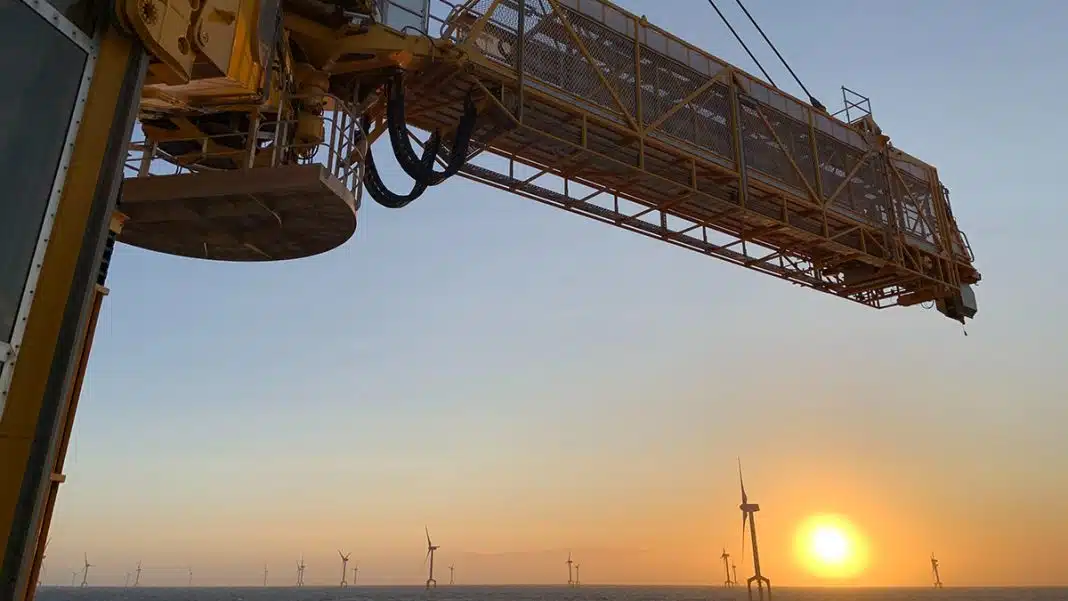By optimising the transfer of supplies and technicians from ship to turbine platform, MacGregor’s innovative ‘Horizon’ gangway is enlarging the operational time available to the vessels supporting the rapid growth of offshore wind energy market.
Geopolitical events through 2022-2023 continue to destabilise energy markets, with fossil fuel price volatility bringing short-term challenges and opportunities for global shipping. By comparison, economic projections for the offshore wind industry are more predictable, with commitments to grow capacity both a matter of public record and a measurable sign of progress towards a more sustainable energy mix.
The 2023 Global Offshore Wind Report, published by the Global Wind Energy Council, predicts the addition of over 380 GW of offshore wind capacity, across 32 markets in the next ten years. More than 3,000 turbines are expected to be installed in Europe alone by the end of 2027.
In the immediate term, vessel day rates have also been growing fast, at 35% above their level 12 months earlier at the end of June 2023. Wind turbine installation vessel orders also reflect a sector looking forward with confidence: Clarksons reported 66 commissioning service operation vessels (CSOVs) and crew transfer vessels on order at the end of first half of the year – annualised as 20% ahead of the 110 counted for the whole of 2022.
Optimising safety, efficiency and performance
But the predictability does not extend to the weather, which is one reason a personnel and cargo transfer solution from marine and offshore load handling specialist MacGregor has recently been turning heads.
Selecting the right solutions to transfer supplies and personnel safely and efficiently between a CSOV and a turbine platform will be one of the key decisions an owner takes, the supplier advises, given that this activity will often define a vessel’s maximum uptime hours: simply put, its ability to earn money for its owner.
“The ability for walk-to-work gangways and cranes to compensate for sea conditions for a safe transfer of personnel and equipment to the turbine platform will be weighed up in the voyage plan,” says Sindre Halvorsen, Specialist Engineer, Product Owner Gangways.
“Accuracy and reliability in this operation are critical for planning within the safety limits imposed by weather. Effectively, the ability to work alongside determines a vessel’s operational window.”
Developing the most efficient solutions for the wind energy market has involved extensive collaboration with clients, says Halvorsen, with MacGregor contributing at an early stage of vessel design to ensure that the position and performance of its equipment is optimal.
All-electric Horizon active motion compensated gangways
The eye-catching result has been MacGregor’s all-electric ‘Horizon’ walk-to-work gangway, the first examples of which are now in full operation, with deliveries ongoing across a number of CSOVs through 2023.
Available for newbuild ships and for retrofits, the Horizon’s customisable foundations can be integrated with the vessel design and adapted to serve different landing heights and turbine clearance requirements. The solution is also delivered with an extra-wide transfer bridge (1.5m, against a class requirement of 1.2m) for optimised safety, logistics flow, and/or an integrated tower and 26-person elevator to connect goods and technicians between deck and gangway levels.
Based on its design philosophy, but also on feedback from first movers, Halvorsen says the all-electric option is proving increasingly persuasive for gangway specifiers.
“Comparative studies tell us that energy efficiency can be as low as 25% for hydraulic load handling equipment, while electric solutions achieve above 75%,” he says. “Where the Horizon walkway is concerned, the amount of energy needed for operations is very low – amounting to less than 200 kWh per day.
“Based on efficiency, but also on the increasing focus energy suppliers place on sustainability – and especially on CO2 emissions – our expectation is that all-electric transfer solutions may soon come under consideration for inclusion in charter party agreements.”
The Horizon gangway features redundancy that goes beyond class requirements, with an entire electrical system maintaining control and safety levels to handle any single failure.
Automatic choice
The Horizon’s efficiency is also enhanced as a result of its ability to interface with other shipboard systems. MacGregor’s Colibri™ 3D motion compensated crane, for example, has built a reputation for flexibility and agility under load, and for its greater precision while less mass is in motion. Service vessels have now been ordered which feature the Horizon gangway system, the Colibri™ 3D motion compensated crane and the ‘AROS’ remote-control station.
Developed in close cooperation with customers, AROS is an augmented reality operator station positioned on the bridge, from where a single operator can switch seamlessly between crane and gangway operations. In addition to the overall efficiency and safety gains during a critical part of alongside operations, the combination provides another means of minimising unplanned downtime and thereby maximising a vessel’s operational window.
Digitalisation is also central to the supplier’s strategy for lifecycle services and support for its offshore wind industry clients, according to Halvorsen.
“Because these vessels only earn when they work, their load and personnel handling equipment must be continuously available. Predictive maintenance is a key tool which can enable remote support and enhance planning for scheduled inspections and maintenance.”
Several recent specifications for COSVs have included OnWatch Scout (OWS) – MacGregor’s condition monitoring and predictive maintenance application. The predictive software analyses operational data streamed directly from the vessel in order to detect patterns which might indicate risk of failure, optimise planned maintenance and minimise unplanned downtime.
“The ability to offload and recover technicians at the turbine is one of the defining features of offshore wind support vessel utility. Understandably, owners are going to opt for the gangway that allows planned voyages to go ahead, while less well-equipped vessels may have to stay at home.”













